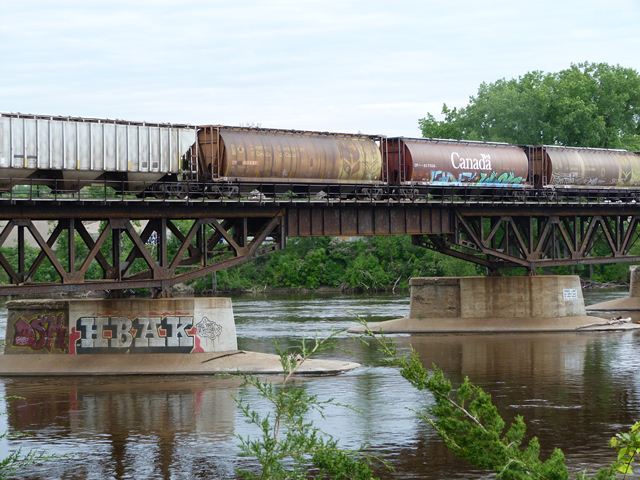We Recommend:
Bach Steel - Experts at historic truss bridge restoration.
BridgeHunter.com Phase 1 is released to the public! - Visit Now
Camden Place Rail Bridge

Primary Photographer(s): Nathan Holth
Bridge Documented: June 3, 2013
Railroad (Canadian Pacific) Over Mississippi River and St. Anthony Parkway
Minneapolis: Hennepin County, Minnesota: United States
Metal Cantilever Rivet-Connected Warren Deck Truss, Fixed and Approach Spans: Metal Rivet-Connected Warren Deck Truss, Fixed
1905 By Builder/Contractor: Minneapolis Steel and Machinery Company of Minneapolis, Minnesota
1936
125.0 Feet (38.1 Meters)
904.0 Feet (275.5 Meters)
Not Available
3 Main Span(s) and 8 Approach Span(s)
Not Applicable

View Information About HSR Ratings
Bridge Documentation
Additional Information: John Marvig provided the following information. This bridge was built in 1905 and extended in 1936. Further modifications occured at unknown dates. Newmann and Hay of St. Paul, Minnesota was the substructure contractor and Minneapolis Steel & Machinery Co. was the superstructure contractor.
From East to West:
10' Concrete Slab
55' Through Plate Girder
1-100'; 2-110' Warren Deck Truss
1-125' Suspended Deck Plate Girder
1-110';1-115';1-110' Warren Deck Truss
2 Span Steel Stringer
In addition, there are five deck plate girder spans near the west end of the bridge that branch off, carrying an abandoned line to the former north/south industrial line connecting from the Soo Line to the Great Northern in downtown Minneapolis. These five spans are known as the south wye spans.
This bridge is an unusually short example of a deck cantilever truss. The bridge's cantilever spans also have an unusual appearance, and are somewhat simple in design given the short length. Over the navigation channel, metal truss cantilever arms extend outward from the piers, to hold a riveted plate girder that is not as deep as the ends of the cantilever arms. This riveted plate girder is reportedly not original to the bridge and was placed in 1977 as a replacement for the original suspended span (perhaps a truss that would have been as deep as the ends of the cantilever arms). The more shallow girder was replaced to provide greater clearance for boats. While the plate girder may have been placed in 1977, it is clearly an older plate girder that was salvaged and reused, since it uses a riveted construction that would likely not have been used in 1977 in new construction. In addition to the unusual cantilever spans, this bridge has some simple deck truss spans and a couple steel stringer spans. The bridge also passes over the St. Anthony Parkway, however those spans are not original and date to 1936 according to the plaque. The overpass consists of a through plate girder span and a short concrete slab span over the sidewalk.
![]()
Photo Galleries and Videos: Camden Place Rail Bridge
Bridge Photo-Documentation
Original / Full Size PhotosA collection of overview and detail photos. This gallery offers photos in the highest available resolution and file size in a touch-friendly popup viewer.
Alternatively, Browse Without Using Viewer
![]()
Bridge Photo-Documentation
Mobile Optimized PhotosA collection of overview and detail photos. This gallery features data-friendly, fast-loading photos in a touch-friendly popup viewer.
Alternatively, Browse Without Using Viewer
![]()
Maps and Links: Camden Place Rail Bridge
Coordinates (Latitude, Longitude):
Search For Additional Bridge Listings:
Bridgehunter.com: View listed bridges within 0.5 miles (0.8 kilometers) of this bridge.
Bridgehunter.com: View listed bridges within 10 miles (16 kilometers) of this bridge.
Additional Maps:
Google Streetview (If Available)
GeoHack (Additional Links and Coordinates)
Apple Maps (Via DuckDuckGo Search)
Apple Maps (Apple devices only)
Android: Open Location In Your Map or GPS App
Flickr Gallery (Find Nearby Photos)
Wikimedia Commons (Find Nearby Photos)
Directions Via Sygic For Android
Directions Via Sygic For iOS and Android Dolphin Browser
USGS National Map (United States Only)
Historical USGS Topo Maps (United States Only)
Historic Aerials (United States Only)
CalTopo Maps (United States Only)

